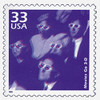
# 3187o - 1999 33c Celebrate the Century - 1950s: Movies Go 3-D
US #3187o
1999 Movies Go 3-D – Celebrate the Century (1950s)
• Part of the sixth sheet in the Celebrate the Century stamp series issued from 1998-2000
• Commemorates the introduction of 3-D movies
• Includes text on the back with historical details
Stamp Category: Commemorative
Series: Celebrate the Century
Value: 32¢ First Class Mail Rate
First Day of Issue: May 26, 1999
First Day City: Springfield, Massachusetts
Quantity Issued: 188,000,000
Printed by: Ashton Potter (USA) Ltd.
Printing Method: Offset, Intaglio
Format: Panes of 15
Perforations: 11.5
Tagging: Block Tagging
Why the stamp was issued: To celebrate the first 3-D movies and their lasting impact on the film industry.
About the stamp design: Pictures a photograph from a 1950s article on 3-D films. The red and blue parts of the design give the suggestion of a 3-D effect. Includes the following text on the back: “Responding to the growing popularity of TV, film studios began producing 3-D movies. Wearing glasses with gray Polaroid lenses, viewers were startled by images that leapt off the screen.”
First Day City: The First Day of Issue Ceremony was held at the Civic Center in Springfield, Massachusetts, the hometown of Dr. Seuss.
About the Celebrate the Century series: The USPS launched the Celebrate the Century series in 1998 to mark the end of the 20th century and herald the arrival of the 21st. The series includes 10 sheets of 15 stamps (150 in total), with each honoring important moments from a different decade (1900s, 10s, 20s, 30s, 40s, 50s, 60s, 70s, 80s, and 90s). At the time of completion, it was the longest and most ambitious commemorative stamp series in US history.
History the stamp represents: A variety of fads came and went during the 1950s, including 3-D movies, or “deepies.” With the increasing popularity of television, movie audiences were dwindling. The motion picture industry was groping for a gimmick to renew America’s interest in the theater when the Natural Vision Corporation came up with 3-D.
One type of 3-D movie featured a large curved screen to produce three-dimensional pictures. Others used the stereoscopic principle, where two overlapping film images were simultaneously projected. Audience members wore special eyeglasses that refocused the view, creating a three-dimensional image.
The first 3-D movie, “Bwana Devil,” premiered on November 26, 1952, in Los Angeles. Film makers doubted that people would go see a movie where they had to wear special glasses. The film disproved that theory, and broke box-office records with a first week gross of $95,000 (which was momentous at that time). Critics agreed that the movie’s story of man-eating lions who harass railroad builders in Africa was less than impressive. But audiences were amazed by the optical illusions of beasts that seemed to leap from the screen.
The 3-D movie fad was a short-lived one, most likely because of the unimaginative plots featured in the films.
US #3187o
1999 Movies Go 3-D – Celebrate the Century (1950s)
• Part of the sixth sheet in the Celebrate the Century stamp series issued from 1998-2000
• Commemorates the introduction of 3-D movies
• Includes text on the back with historical details
Stamp Category: Commemorative
Series: Celebrate the Century
Value: 32¢ First Class Mail Rate
First Day of Issue: May 26, 1999
First Day City: Springfield, Massachusetts
Quantity Issued: 188,000,000
Printed by: Ashton Potter (USA) Ltd.
Printing Method: Offset, Intaglio
Format: Panes of 15
Perforations: 11.5
Tagging: Block Tagging
Why the stamp was issued: To celebrate the first 3-D movies and their lasting impact on the film industry.
About the stamp design: Pictures a photograph from a 1950s article on 3-D films. The red and blue parts of the design give the suggestion of a 3-D effect. Includes the following text on the back: “Responding to the growing popularity of TV, film studios began producing 3-D movies. Wearing glasses with gray Polaroid lenses, viewers were startled by images that leapt off the screen.”
First Day City: The First Day of Issue Ceremony was held at the Civic Center in Springfield, Massachusetts, the hometown of Dr. Seuss.
About the Celebrate the Century series: The USPS launched the Celebrate the Century series in 1998 to mark the end of the 20th century and herald the arrival of the 21st. The series includes 10 sheets of 15 stamps (150 in total), with each honoring important moments from a different decade (1900s, 10s, 20s, 30s, 40s, 50s, 60s, 70s, 80s, and 90s). At the time of completion, it was the longest and most ambitious commemorative stamp series in US history.
History the stamp represents: A variety of fads came and went during the 1950s, including 3-D movies, or “deepies.” With the increasing popularity of television, movie audiences were dwindling. The motion picture industry was groping for a gimmick to renew America’s interest in the theater when the Natural Vision Corporation came up with 3-D.
One type of 3-D movie featured a large curved screen to produce three-dimensional pictures. Others used the stereoscopic principle, where two overlapping film images were simultaneously projected. Audience members wore special eyeglasses that refocused the view, creating a three-dimensional image.
The first 3-D movie, “Bwana Devil,” premiered on November 26, 1952, in Los Angeles. Film makers doubted that people would go see a movie where they had to wear special glasses. The film disproved that theory, and broke box-office records with a first week gross of $95,000 (which was momentous at that time). Critics agreed that the movie’s story of man-eating lions who harass railroad builders in Africa was less than impressive. But audiences were amazed by the optical illusions of beasts that seemed to leap from the screen.
The 3-D movie fad was a short-lived one, most likely because of the unimaginative plots featured in the films.













